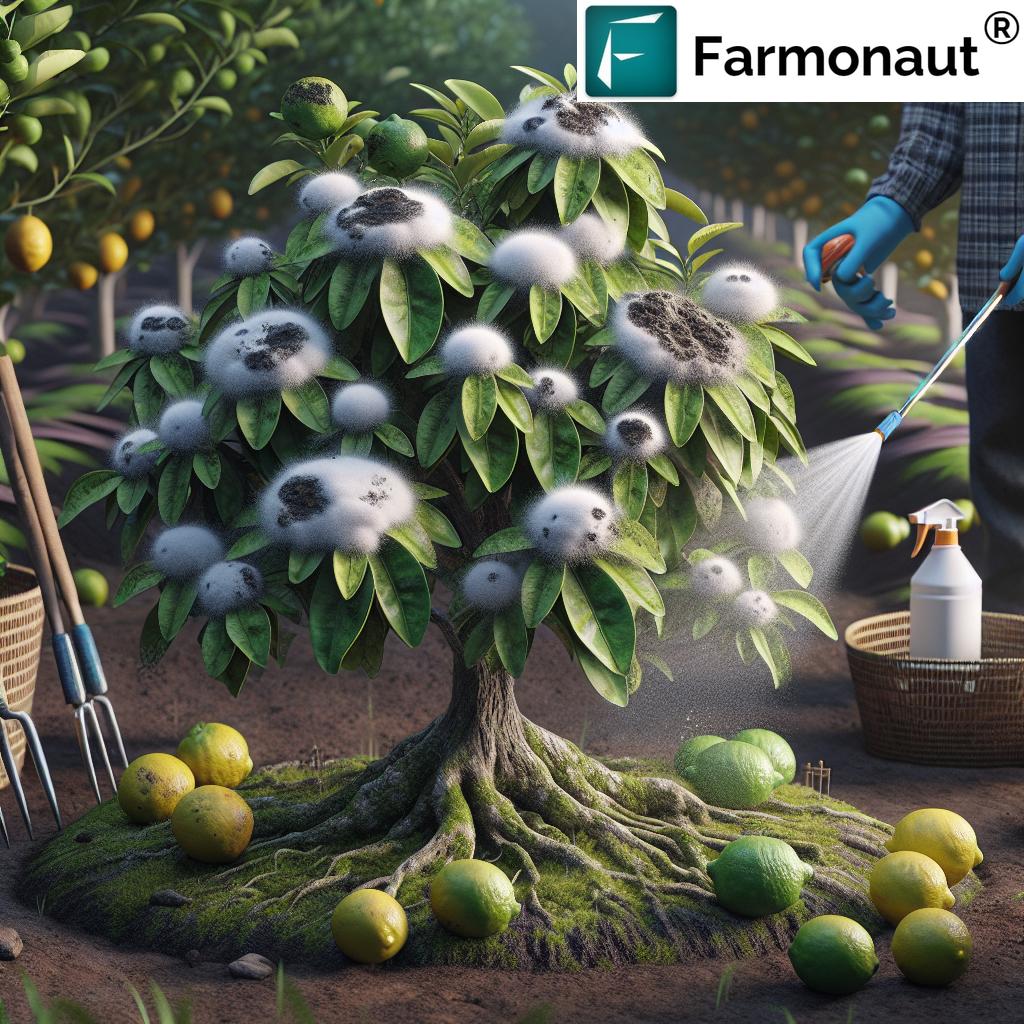Lemon Tree Bugs: 7 Powerful Ways to Control Pests & Diseases
Table of Contents
- Overview: The Importance of Lemon Tree Pest Control & Disease Management
- Common Lemon Tree Pests: Identification & Impact
- Common Lemon Tree Diseases: Symptoms & Solutions
- 7 Powerful Ways to Control Lemon Tree Pests & Diseases
- How Technology Empowers Lemon Growers
- Lemon Tree Pests & Disease Management Summary Table
- FAQs: Lemon Tree Pest Control & Disease Management
- Additional Resources & Farmonaut Links
- Conclusion: Sustaining Robust Lemon Orchards
Overview: The Importance of Lemon Tree Pest Control & Disease Management
Lemon trees (Citrus limon), whether grown in home gardens, commercial orchards, or small homesteads, are cherished for their vibrant, tangy fruits and aromatic leaves. Yet these trees are highly susceptible to a range of pest infestations and common diseases that threaten their health, foliage, and overall productivity.
Understanding these threats and implementing effective management strategies is foundational to safeguarding lemon tree growth and ensuring a robust yield of fruit season after season.
Early identification and proactive action can mean the difference between thriving lemon trees brimming with fruit, and a diminished or even lost harvest. This comprehensive guide covers in detail the key lemon tree pests and diseases, clear signs of trouble (like curled or yellowing leaves, sticky honeydew, or sooty mold), and the science-backed approaches for lemon tree pest control and citrus tree disease management.
Whether you’re a backyard gardener in Florida, a farmer in India, or managing citrus orchards anywhere in the world, implementing the right blend of cultural, biological, and chemical controls along with innovative technology not only protects your investment but helps build sustainable, environmentally friendly citrus farming.
Common Lemon Tree Pests: Identification & Impact
Let’s dive into the world of pests that commonly attack lemon trees and take a toll on leaf health, young shoots, and fruit development.
Lemon Tree Pest Control: Key Offenders
-
Aphids (Toxoptera citricida)
These small, soft-bodied insects primarily target new growth. They pierce the sap-carrying tissues of lemon leaves and young shoots, feeding voraciously. Their feeding leads to deformed leaves, leaf drop, and excretion of honeydew—a sticky substance that promotes sooty mold growth.
Key signs: Curling or misshapen leaves, shiny sticky coating, black mold spots, visible clusters of tiny insects (often green, brown, or black) on shoot tips. For severe infestations, targeted insecticidal treatments may be required. -
Citrus Leaf Miner (Phyllocnistis citrella)
Leaf miners are tiny larvae that burrow into new leaves, creating distinctive winding trails or “mines”. This scars the leaf, reduces photosynthetic area, weakens the tree, and can make it more vulnerable to disease.
Symptoms: Silvery, serpentine patterns winding through young leaves, distorted leaf growth, reduced plant vigor.
Learn more: How to treat lemon tree leaf miners -
Whiteflies (Trialeurodes vaporariorum)
These tiny white “moth-like” insects feed mainly on the undersides of leaves. Their feeding and honeydew secretion fosters sooty mold and may spread viral diseases.
Look for: Yellowing, sticky leaves with black mold and clouds of tiny flying white insects when disturbed. -
Mealybugs (Planococcus citri)
Characterized by a white, waxy coating and often clustering in dense groups at leaf or stem junctions. Mealybugs suck sap, resulting in yellowing, stunted growth, and leaf drop.
Watch out for: Cottony white masses, sticky surfaces, and ant activity (ants “farm” mealybugs for honeydew). -
Citrus Swallowtail Caterpillar (Papilio demodocus)
This caterpillar can cause significant defoliation of lemon trees, especially young ones. It may be large and camouflaged, resembling bird droppings.
Damage: Missing leaves, ragged foliage, presence of visible green/brown caterpillars. -
Citrus Red Mite (Panonychus citri)
These mites attack the upper leaf surface, causing brown necrotic areas. Severe infestations may result in premature leaf drop, reduced health, and lower fruit yield. -
Citrus Rust Mite (Phyllocoptruta oleivora)
Rust mite is more of a problem on mature lemon trees and fruit. It causes silvery stains on fruit rinds, leaf speckling, and sometimes leaf drop. -
Lemon Bud Moth (Prays citri)
Bud moth attacks are most common during blossom time. Larvae feed on young flowers and fruits, causing external and internal fruit damage (brown patches, holes, stunted fruit).
Common Lemon Tree Diseases: Symptoms & Solutions
Next, let’s examine the most prevalent fungal and bacterial diseases in citrus trees — each requiring different intervention and vigilant control for lemon growers.
Citrus Tree Disease Management: Major Lemon Tree Diseases
-
Citrus Black Spot (Phyllosticta citricarpa)
This fungal disease causes dark lesions on fruit and leaves, lowering market value and yield. Affected fruit often show black spots, rough patches, or early drop.
Management: Remove all infected fruits and leaves; use recommended fungicides during humid/rainy weather. -
Citrus Canker (Xanthomonas citri)
A devastating bacterial disease that presents as raised lesions on leaves, stems, and fruit. It results in defoliation and fruit drop.
Important: No known cure exists; prune and destroy infected parts to prevent the spread. Citrus canker information -
Powdery Mildew (Leveillula taurica)
Appears as a white, powdery coating on leaves, stems, and buds, stunting growth and reducing fruit production.
Control: Prune affected branches promptly. Apply fungicides labeled for citrus (see table below).
See: Lemon tree powdery mildew treatment -
Root Rot (Phytophthora citrophthora)
This soil-borne disease causes root decay, eventually leading to yellowing leaves, wilting, and poor fruit set.
Best prevention: Well-drained soil, never overwater, and maintain good soil aeration. -
Citrus Greening/HLB (Huanglongbing)
HLB (Huanglongbing) is a bacterial disease spread primarily by the Asian psyllid. It causes yellowing and mottling of leaves, stunted growth, and deformed, bitter fruits.
Crucial: Control psyllid insect populations immediately and remove all infected trees without delay. Learn about precision pest monitoring tools for HLB risk.
7 Powerful Ways to Control Lemon Tree Pests & Diseases
Protecting your lemon trees from the onslaught of pests and diseases means more than reacting to visible damage. Successful lemon tree pest control and citrus disease management relies on a multi-pronged, proactive approach—best encapsulated in the principles of Integrated Pest Management (IPM) for lemon trees.
Integrated Pest Management for Lemon Trees: Combining Best Practices
IPM unites cultural, biological, and chemical methods in a practical, sustainable system. Below, we detail seven highly effective, research-backed ways to treat, control, and prevent lemon tree pests and diseases.
-
1. Cultural Practices for Citrus Health
- Regular, proper pruning: Remove affected, damaged, or infested branches and leaves to prevent spread.
- Optimize watering: Avoid overwatering—ensure well-drained soils to prevent root rot and fungal growth.
- Fertilize appropriately: Use a balanced citrus fertilizer, ensuring trees have sufficient nutrients, but avoid overfertilizing as this can fuel soft growth attractive to pests.
- Orchard hygiene: Remove fallen leaves and fruit promptly, eliminating sources of reinfection.
- Ensure proper spacing: Plant trees far enough apart to allow airflow, reducing humidity and mildew risk.
-
2. Natural Ways to Control Citrus Pests (Biological Controls)
- Encourage beneficial insects: Ladybugs and lacewings are natural predators of aphids, mealybugs, and whiteflies. Favor their presence by minimizing broad-spectrum pesticide use and planting companion flowers nearby.
- Parasitoid wasps: Useful against leaf miner larvae and some caterpillar pests.
- Ant control: Control ant populations that “farm” honeydew-producing pests.
-
3. Mechanical and Physical Controls
- Yellow sticky traps: Effective for whiteflies control. Place these traps near affected trees to monitor and directly reduce adult populations.
- Manual removal: Pick off caterpillars and large cluster pests. Remove and destroy heavily infested plant parts (e.g., leaves with citrus leaf miners or mealybug colonies).
-
4. Targeted Use of Horticultural Oils and Soaps
- Horticultural oil sprays: Smother aphids, mites, mealybugs, and whiteflies, particularly in non-flowering periods. Oils can also help contain citrus leaf miner damage on young leaves.
- Insecticidal soaps: Especially effective against soft-bodied pests. Ensure thorough coverage, especially on leaf undersides.
-
Learn about eco-friendly alternatives for lemon tree bugs
-
5. Judicious Application of Pesticides and Fungicides
- Choose appropriate, targeted chemical treatments: Reserve for severe infestations—such as persistent outbreaks of aphids, mites, or leaf miners. Rotate chemicals to prevent resistance.
- Powdery mildew in lemon trees: Apply sulfur-based or systemic fungicides as a lemon tree powdery mildew treatment.
- Miticides: Targeted for red mite or rust mite infestations—avoid harming beneficial insects.
- Treat only as directed: Always follow professional recommendations and product labels for timing and safety.
-
6. Plant Disease-Resistant Varieties & Grafting
- Select lemon tree varieties with genetic resistance to local bacterial and fungal diseases whenever possible—the best prevention begins at planting.
- When propagating, use only certified, disease-free rootstock and scions.
-
7. Ongoing Monitoring, Diagnosis & Smart Technology Solutions
- Monitor regularly: Inspect your citrus trees and lemon leaves weekly for early signs—distorted leaves, mines, spots, sticky secretions, or yellowing. Early detection is vital for effective intervention.
- Leverage digital tools: Advanced satellite crop health monitoring from Farmonaut enables large and small growers to detect stress from pests, diseases, or nutrient issues at scale, well before symptoms become obvious to the naked eye. This makes farm-wide pest and disease management efficient, targeted, and data-driven.
How to Treat Lemon Tree Leaf Miners & Similar Pests
- Prune off and discard all affected young leaves showing winding “mines”.
- Encourage natural parasites and avoid heavy chemical use where possible.
- Apply horticultural oils during periods of active larval infestation to reduce leaf miner populations.
How to Treat Lemon Tree Leaf Miners (Detailed Guide)
Managing Aphids on Citrus Trees—Practical Steps
- Spray cold water or apply insecticidal soap to dislodge small populations.
- Use sticky barriers to keep ants away (reduces aphids and mealybugs).
- Release ladybugs or encourage their local population for natural aphid reduction.
See table below for more options.
Yellowing Leaves on Lemon Trees—Diagnosing the Problem
- Yellowing leaves can indicate nutrient deficiency (especially nitrogen or iron), root rot from overwatering, or be an early signal of HLB, aphid infestation, powdery mildew, or mite damage.
- Check undersides for pest activity or sticky substances.
Yellowing may be seasonal (shedding older leaves), but widespread yellowing needs prompt diagnosis and action.
Integrating Farmonaut’s satellite monitoring and AI-advisory tools into your citrus management strategy gives you real-time health reports, pest alerts, and prevention recommendations, greatly reducing risk and yield loss. Available via web, android, and iOS platforms, these tools fit the needs of individual growers, cooperatives, and large commercial orchards alike.
How Technology Empowers Lemon Growers: Farmonaut’s Role
While traditional techniques are crucial for lemon tree pest control, technology-based solutions provide farmers with tools to scale their efforts, detect problems early, and minimize damage—especially across large and complex citrus orchards.
Farmonaut’s Technology for Citrus Pest & Disease Management
-
Satellite-Based Crop Health Monitoring:
Farmonaut utilizes advanced satellite imagery and AI to pinpoint vegetation stress caused by pest, disease, or nutrient issues, often before visible symptoms occur. Early alerts improve intervention success and can be life-saving for entire orchards. - Jeevn AI Advisory System: This real-time, intelligence-powered advisory service integrates environmental, plant, and satellite data to produce customized advice on lemon tree disease and pest management.
- On-Farm Decision Support: Growers use Farmonaut’s mobile and web apps to track pest infestations, monitor yellowing or powdery mildew, diagnose sources of leaf drop, and optimize chemical treatments, making farm management more efficient.
- Blockchain-Based Product Traceability: Gain consumer trust by ensuring lemon fruit is transparently tracked from orchard to packaging using Farmonaut’s traceability solutions.
- Resource Management for Businesses: Fleet management features optimize logistics and agricultural machinery deployment across lemon orchards, saving money and labor.
- Sustainability and Carbon Management: Proactively monitor, report, and reduce your carbon footprint with Farmonaut’s carbon footprinting module—perfect for eco-conscious orchards and enterprises.
- Crop Loan & Insurance Support: Satellite-based health records and verification reduce risks for growers and insurers, making access to finance faster and fairer for lemon farmers.
For a seamless, science-driven approach to lemon orchards and pest monitoring, Farmonaut’s platform provides all-in-one precision agriculture, pest management, and sustainability tools within your budget.
Lemon Tree Pests & Disease Management Summary Table
| Pest/Disease Name | Typical Symptoms | Estimated Damage Level (% yield loss) |
Suggested Control Method | Estimated Effectiveness (%) | Preventive Tips |
|---|---|---|---|---|---|
| Aphids (Toxoptera citricida) |
Curled/deformed new leaves, sticky honeydew, clusters on shoots | Up to 25% | Biological: Ladybugs, insecticidal soap; Chemical: Systemic insecticides for severe outbreaks | 80-90% | Encourage natural predators and avoid over-fertilization |
| Citrus Leaf Miner (Phyllocnistis citrella) |
Winding “mines” in young leaves, misshapen foliage | Up to 30% | Cultural: Pruning; Biological: Parasitoids; Horticultural oils | 70-95% | Remove affected leaves quickly; plant pest-resistant varieties |
| Whiteflies (Trialeurodes vaporariorum) |
Yellowing, sticky leaves, sooty mold underneath | 15-20% | Yellow sticky traps, neem oil/insecticidal soap, natural predators | 80-90% | Monitor regularly, control ants, maintain orchard hygiene |
| Mealybugs (Planococcus citri) |
Cottony white masses, yellowing, leaf drop | 15-25% | Manual removal, natural predators, systemic insecticides | 80-90% | Trim infested parts, control ants, watch for early outbreaks |
| Caterpillar (Papilio demodocus) |
Missing/chewed leaves, visible green-brown caterpillars | Up to 40% on young trees | Manual removal, targeted insecticides | 80% | Inspect regularly, especially during new flush |
| Citrus Red Mite (Panonychus citri) |
Brown spots, necrosis on upper leaf, leaf drop | Up to 20% | Appropriate miticides (targeted), monitor frequently | 80-90% | Maintain a clean orchard, avoid broad-spectrum pesticides |
| Citrus Black Spot | Dark fruit/leaf lesions, premature fruit drop | Up to 50% | Remove affected fruit, apply approved fungicides | 75-85% | Sanitize tools, avoid overhead irrigation |
| Powdery Mildew | White powdery coating on leaves/stems | 10-20% | Prune infected branches, sulfur/systemic fungicides | 80-95% | Maintain airflow, remove infected debris |
| Canker | Raised leaf/fruit/stem lesions, rapid drop | Up to 60% | Remove and destroy infected trees/branches | 70% (with swift action) | Use certified plant material, prompt removal |
| HLB (Citrus Greening) | Yellowing, stunted growth, bitter fruit | 60-100% | Remove infected trees, control psyllids | 50-70% prevent spread | Early pest control, monitor for symptoms, source clean stock |
FAQs: Lemon Tree Pest Control & Disease Management
What is the best way to deal with lemon tree pests?
The most effective method is to adopt integrated pest management (IPM) practices, which combine cultural, biological, and targeted chemical controls. Regular inspection, early intervention, and leveraging natural predators (like ladybugs and lacewings) greatly reduce pest risk. For widespread issues, use pesticidal soaps, oils, or chemical treatments as recommended for the specific pest.
How do I recognize fungal diseases in citrus trees?
Fungal diseases (like black spot, powdery mildew) often appear as spots, powdery coatings, or lesions on leaves and fruit. Look for white mold, black, brown, or yellow spots, and areas of decay. Good air circulation and quick removal of infected material help, along with fungicidal sprays.
What causes yellowing leaves on lemon trees?
Yellowing leaves may signal nutrient deficiencies (typically nitrogen), poor drainage or root rot, pest infestations (aphids, mites), or early signs of HLB (citrus greening). Inspect leaf undersides for insects, ensure soil drains well, and use balanced fertilizer.
Can I use natural ways to control lemon tree bugs?
Yes, natural pest management is possible and effective for many outbreaks. Encourage ladybugs, parasitic wasps, and use neem or horticultural oils. Remove affected leaves by hand and maintain a clean orchard for best results.
Is there a way to monitor lemon tree health at scale?
Farmonaut’s satellite crop health monitoring platform is designed for this task. We use precision imaging, AI-driven alerts, and actionable dashboards so you can monitor, diagnose, and manage pest and disease outbreaks across large orchards or multiple locations. Try the platform today.
Additional Resources & Farmonaut Links
- Carbon Footprinting Solutions – Track and reduce your orchard’s environmental footprint.
- Blockchain-Based Traceability – Transparent citrus supply chain from field to shelf.
- Crop Loan & Insurance Tools – Simpler, faster financial support using satellite evidence.
- Fleet & Resource Management Dashboard – For citrus agribusinesses seeking efficiency.
- Large Scale Farm Management (Web & Mobile App) – AI-powered dashboard for lemon and citrus orchard administrators.
- Crop Plantation, Forest Advisory & More – Including advanced pest, water, and disease alerts for citrus growers.
Conclusion: Sustaining Robust Lemon Orchards
Lemon trees are a valuable resource, but their leaves, fruit, and overall health are challenged by a variety of pests and diseases—from aphid infestations causing leaf curl and sooty mold, to powdery mildew, canker, and devastating HLB. By embracing integrated pest management for lemon trees, combining cultural practices (like pruning and orchard hygiene), biological controls (such as ladybugs and lacewings), and chemical solutions (targeted pesticides/fungicides), lemon growers can maintain productivity and minimize loss.
Today, growers can supercharge results by harnessing digital tools like Farmonaut’s crop health monitoring platform, offering early detection, data-backed advice, and seamless management even at commercial scale. With these insights, plus well-informed prevention and intervention strategies, the future of lemon orchard health—whether in a small backyard or a vast plantation—is bright.
Protect your citrus investments, boost yields, and practice sustainability—explore Farmonaut’s ecosystem of technologies and see the power of smarter lemon tree pest control and disease management in action.












